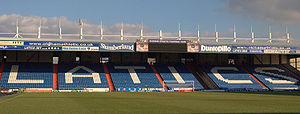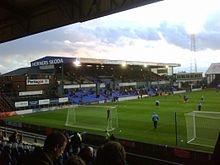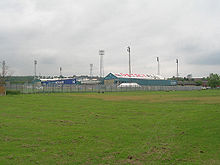- Boundary Park
-
Boundary Park Ice Station Zebra 
Rochdale Road stand which houses Away Supporters.Full name Boundary Park Stadium Location Boundary Park, Oldham OL1 2PA Coordinates 53°33′19″N 2°7′43″W / 53.55528°N 2.12861°WCoordinates: 53°33′19″N 2°7′43″W / 53.55528°N 2.12861°W Built 1904 Opened 1 August 1904 Renovated 2008 Capacity 10,638 Field dimensions 110 × 74 yd (100 × 68 m) Tenants Oldham Athletic A.F.C. (1904–)
Oldham Roughyeds (1997–2001, 2003–2009)Boundary Park is the main sports stadium of Oldham, in Greater Manchester, England. It lies at the northwestern extremity of Oldham, with the towns of Royton and Chadderton lying immediately north and west respectively, giving rise to the name Boundary Park.[1]
Boundary Park was originally known as Athletic Ground when it was opened in 1896 for Oldham's first professional association football club, Oldham County F.C.. When County folded in 1899, Pine Villa F.C. took over the ground and changed their name to Oldham Athletic.[2] Oldham Athletic A.F.C. have played their home games here since the stadium was opened. Oldham RLFC left their traditional home, Watersheddings, in 1997 and moved to Boundary Park. Apart from the 2002 season when they played at Hurst Cross in Ashton-under-Lyne, they played there until 2009, when the football club no longer wanted them as tenants.
Contents
Overview
Boundary Park at the moment is unique in English professional football as it is the only one that has three stands with one whole side missing. The Lookers Stand on the Broadway side was knocked down as part of a proposed redevelopment (see below). However, the redevelopment was scrapped and Oldham Athletic are no longer working on this project. The hardcore Oldham fans are usually considered to be in the Chadderton Road End (Chaddy End); a traditional, small, one - tiered stand. Opposite that is the Rochdale Road End, where one third of the stand is given to away supporters, and home fans the rest, except when the opposition has a large away following, when the situation is reversed. In these cases, season ticket holders have to be shifted. The main stand that has been there since the stadium was first built, is a small two - tiered structure. Terracing disused since the conversion to an all-seater can still be seen towards the end of this stand.
Capacity
The stadium currently has an all-seated capacity of 10,638. It became an all-seater venue during the 1994-95 season - the season after Oldham Athletic's relegation from the top flight of English football. In the early days, the stadium could hold nearly 50,000 people. The highest crowd ever recorded at Boundary Park is 47,671, for an FA Cup tie between Oldham and Sheffield Wednesday in 1930.
"Fantastic in Plastic"
In 1986 the club installed an artificial pitch in order to generate more income for the club and this coincided with the club's upturn in fortunes under manager Joe Royle. In 1987, the club reached the play-offs and in 1989/90 the club went through what is regarded as the club's greatest-ever season, reaching the League Cup Final and the semi-final of the FA Cup, and the club claimed major upsets against the likes of Arsenal, Southampton, Everton and Aston Villa. Critics felt that the pitch gave the club an advantage, but in 1991 Royle responded to this when the Portsmouth manager declared that Oldham couldn't play away, he stuck the article to the dressing room door and the team responded with a 4-1 victory. At the end of the 1990/91 season the club secured promotion to the top flight, the final match on the plastic pitch was probably one of the most memorable games played at the ground when Latics, in order to win the old second division, had to beat Sheffield Wednesday and rely on West Ham losing. 60 minutes into the game, Wednesday were 2-0 up, but Ian Marshall pulled a goal back, then Paul Bernard equalised. By this point, West Ham were losing. In time added on, Andy Barlow went down in the box and the referee awarded a penalty. Neil Redfearn stepped up to convert it and a mass pitch invasion followed, as it had been confirmed that West Ham had lost 2-1 to Notts County. With promotion to the top flight, Oldham Athletic were then forced to have the plastic pitch removed because of league rules. They stayed in the top league for 3 seasons ( 1991–92, 1992–93 and 1993-4) before being relegated, and after 3 seasons in the second tier were relegated again in 1997. They have been in the third division, now called League One, ever since.
Records
Boundary Park is anecdotally known as being the coldest ground in the Football League, earning the nickname coined by Joe Royle, Ice Station Zebra.[4] It is also the third-highest stadium, at 155 metres above sea level, of any Premier League or Football League club[5] after The Hawthorns, home of West Bromwich Albion, 168 metres, and Vale Park, home of Port Vale F.C., 160 metres.[6]
Redevelopment
There were plans in the late 1990s for a move to a new stadium on adjoining waste ground, but these were scrapped.
On 15 February 2006, the club unveiled plans for the redevelopment of their current ground. The plans would see every stand other than the Rochdale Road end being redeveloped. When completed it would be a 16,000 seater stadium, estimated to cost £80 million, and with a working name of the "Oldham Arena".[7] However, by the time of the completion of the redevelopment, the stadium would likely have borne a sponsor's name.
On 14 November 2007, Oldham Athletic received planning permission for the Broadway stand, whilst Oldham Borough Council rejected the further development of the stadium due to local objections regarding the height and size of a proposed block of apartments. On 12 December 2007, after amending the plans, another council meeting gave permission for redevelopment. Facilities would include conferencing and a hotel plus the option of a casino.[8]
Demolition of the Broadway Stand started on 8 May 2008, with the work completed before the start of the new season. The building of the new 'Main Stand' was due to commence in December 2008 and was expected to take 16 months.[9]
On 5 September 2008, Simon Blitz told podcast World Soccer Daily that although Oldham still planned to continue the development of Boundary Park and surrounding areas, the plans were on hold for now because of the financial crisis of 2007–2010 and the subsequent downturn in the UK property market. He also stated that even though the demolition of the Broadway Stand had been completed, they could not secure a loan to even build the Main Stand, let alone the rest of the project. He stated that the work would continue as soon as the economic climate looked a little better.[citation needed]
Because of the problems, the club announced in the summer of 2009 that it was considering moving to a new stadium in Failsworth. This has caused some controversy amongst supporters as Failsworth has a Manchester postcode and is not considered by some people as part of Oldham, although it is officially within the borough. It is also only thee miles from the City of Manchester Stadium and only one mile from the proposed new stadium of FC United of Manchester in Moston. If all had gone according to plan, the new stadium could have been open by the beginning of the 2011/2012 season but clearly this will not now be the case.
After being led to believe by Oldham Council that the Failsworth site was a deliverable option, the club were extemely disappointed when The Charities Commission turned down their application. Oldham Athletic had wasted millions of pounds on drawing up plans, purchasing land and legal fees - and now believe that 'confidence in the current Council's ability to deliver any proposal for a new stadium is at zero.' [10] Oldham Athletic hold the local council almost completely to blame for the current situation regarding the bleak future of professional sport in the town.[10]
On 28th July 2011 the Council offered the club £5.7 million to help with their redevelopment fund of Boundary Park, which would involve redevelopment of the Broadway Stand, time will tell whether the club will accept the Councils offer. [11]
References
- ^ Alan Godfrey Maps (2008). North Chadderton & SW Royton (Map). Cartography by Ordnance Survey (1932 ed.). Section Lancashire Sheet 97.01. ISBN 978-1-84784-157-5.
- ^ "Boundary Park". pastscape.org.uk. http://www.pastscape.org.uk/hob.aspx?hob_id=890861. Retrieved 2008-07-31.
- ^ "Boundary Park". wikistadiums.org. http://www.wikistadiums.org/boundary-park/71.
- ^ "If you think it’s been cold in Oldham this week, then try visiting John at work!, Jamie Whitehouse, Oldham Advertiser, 3 March 2005
- ^ http://www.midfielddynamo.com/stadia/england_highest.htm
- ^ . http://en.wikipedia.org/wiki/Highest_English_football_stadiums_by_altitude.
- ^ "Latics’ new £80m goal", Carl Marsden, Oldham Advertiser, 15 February 2006
- ^ "Oldham Arena", Oldham Athletic official site, 14 January 2008
- ^ "Latics ready to make a stand in summer", Carl Marsden, Oldham Advertiser, 5 March 2008
- ^ a b http://www.oldhamathletic.co.uk/page/NewsUpdate/0,,10337~2290398,00.html
- ^ [1], Mike Keegan, Manchester Evening News, 28th July 20011
External links
- Boundary Park info from OldhamAthletic.co.uk
Oldham Athletic Association Football Club Related 2011–12 Football League One venues Adams Park · B2net Stadium · Bescot Stadium · Boundary Park · Bramall Lane · Brisbane Road · Broadhall Way · Brunton Park · Colchester Community Stadium · Dean Court · Deepdale · Galpharm Stadium · Gigg Lane · Glanford Park · Griffin Park · Hillsborough · Huish Park · Meadow Lane · Prenton Park · Spotland · St James Park · stadium:mk · The Valley · Victoria ParkPremier League venues Current Anfield · Britannia Stadium · Carrow Road · City of Manchester Stadium · Craven Cottage · DW Stadium · Emirates Stadium · Ewood Park · Goodison Park · Liberty Stadium · Loftus Road · Molineux Stadium · Old Trafford · Reebok Stadium · St James' Park · Stadium of Light · Stamford Bridge · The Hawthorns · Villa Park · White Hart LaneFormer Bloomfield Road · Boleyn Ground · Boundary Park · Bramall Lane · City Ground · County Ground · Elland Road · Fratton Park · Hillsborough Stadium · KC Stadium · Madejski Stadium · Oakwell · Portman Road · Pride Park Stadium · Riverside Stadium · St Andrew's · St Mary's Stadium · Selhurst Park · The Valley · Turf Moor · Valley Parade · Vicarage Road · Walkers StadiumDemolished Super League venues Current Belle Vue • City of Salford Stadium • DW Stadium • Galpharm Stadium • Headingley Carnegie • Halliwell Jones Stadium • KC Stadium • Langtree Park • New Craven Park • Odsal Stadium • PROBIZ Coliseum • Stade Gilbert Brutus • Stobart Stadium • Twickenham StoopFormer Boundary Park • Brewery Field • Central Park • Derwent Park • Don Valley Stadium • Gateshead International Stadium • Hilton Park • Knowsley Road • Racecourse Ground • Stade Sébastien Charléty • The Boulevard • The Shay • Thrum Hall • Valley Parade • Watersheddings • WilderspoolMagic Weekend Co-operative Championship 1 venues Craven Park | Keepmoat Stadium | Thunderdome | New River Stadium | Racecourse Ground | Whitebank Stadium | Spotland Stadium | The Gnoll | Recreation Ground | Derwent Park |
Categories:- Rugby league stadiums in England
- Buildings and structures in Oldham
- Oldham Athletic A.F.C.
- Sports venues in Greater Manchester
- Football venues in England
- 1904 establishments in England
- 1904 in association football
- Premier League venues
Wikimedia Foundation. 2010.


